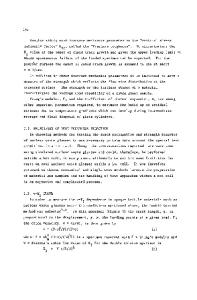Effects of Surface Area-to-Solution Volume Ratio on Chemical Durability of Nuclear Waste Glasses
- PDF / 508,398 Bytes
- 10 Pages / 420.48 x 639 pts Page_size
- 101 Downloads / 335 Views
EFFECTS OF SURFACE AREA-TO-SOLUTION VOLUME RATIO ON CHEMICAL DURABILITY OF NUCLEAR WASTE GLASSES X. FENG, I. L. PEGG, Y. GUO, AA. BARKATT, AND P. B. MACEDO Vitreous State Laboratory, The Catholic University of America, Washington D. C. 20064 ABSTRACT We report data on the relationship between nuclear waste glass durability, as measured by leachate concentrations and leach rates, and the ratio of glass surface area to solution volume, S/V. The study includes West Valley non-radioactive production glasses (SF6 and SF10), West Valley glasses containing U and Th designed at CUA (WVCM47, WVCM50, and WVCM59), Savannah River SRLTDS-131 glass, and Hanford waste glass HW-39 (for which existing literature data is used). While some of these glasses show departures of leachate concentrations from simple (S/V)t scaling others conform well. The departures are, in all cases, most evident at high values of S/V. It is therefore important, therefore to understand how glass composition determines which corrosion mechanism is dominant in order to assess the region of validity of extrapolations based on (S/V)t scaling. While leach rates show a general tendency to decrease with S/V and time, exceptions are evident for the less durable glasses which show minima and maxima in the S/V-dependence at fixed time. INTRODUCTION The ratio of waste glass surface area to solution volume is an important parameter that affects both dissolution and precipitation processes. The effect of this ratio on chemical durability has been investigated in a number of studies. These studies reported that leach rates decrease as the S/V ratios increase
for such
nuclear
waste
glasses
as
PNL-7668
[1-3],
SRP
[4], SRL-165 [3,5], SRL-131 [3,6,7], and British Magnox [8]. Most of these studies also found that glass leaching data for a range of leaching times and S/V ratios can be represented by a single curve when plotted versus the product of S/V and time [1-10]. The product of (S/V)t is a scaling factor which expresses the theoretical expectation that under certain assumptions [11] the leachate concentrations found for waste glasses at a lower S/V for longer times should correspond to accelerated testing results
obtained at a high S/V for shorter times. In this paper we report some of our findings concerning S/V ratio effects on the durability of nuclear waste glasses. These data derive from tests conducted over the last few years, some of which were aimed specifically at elucidating S/V effects, while others were initiated with various related objectives. The data indicate that some glasses show departures from (S/V)t scaling at high values of S/V and that leach rates compared at the same elapsed times do not always decrease with increasing S/V. The observed behavior depends on glass composition, S/V, and time.
EXPERIMENTAL The test matrix is shown in Table 1. With the exception of the data on the Hanford reference glass HW39, which were obtained at Pacific Northwest Laboratory [12], all of the data discussed were obtained from tests conducted at Catholic
Data Loading...











